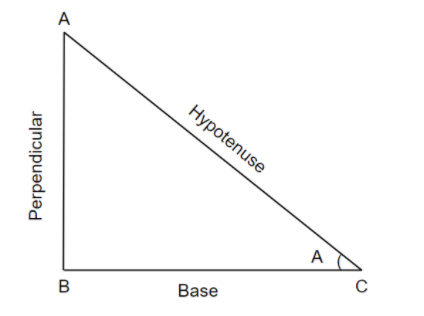
Answer
377.1k+ views
Hint: For solving this question you should know about the general form of trigonometric functions. In this problem we will solve it with the help of a right triangle and applying Pythagoras Theorem on that. That will provide us with the final answer and here we can consider the value of $\theta $ as 2.
Complete step by step answer:
According to our question it is asked of us to prove that ${{\sin }^{2}}2+{{\cos }^{2}}2=1$. Here we can see that this is given in a form of ${{\sin }^{2}}\theta +{{\cos }^{2}}\theta =1$. So, here we can consider the value of $\theta $ as 2. So, now our question is to prove, ${{\sin }^{2}}2+{{\cos }^{2}}2=1$. For this we will use a right triangle. And then we will apply Pythagoras Theorem for proving this and we will also keep in mind that $\dfrac{P}{H}=\sin \theta $ and $\dfrac{B}{H}=\cos \theta $. Here P stands for perpendicular, H stands for hypotenuse and B stands for base. Now if we make a right triangle as follows,

Now, let angle A be $\theta $. We will apply the theorem of Pythagoras Theorem, that is, ${{a}^{2}}+{{b}^{2}}={{c}^{2}}$, where a is the value of perpendicular, b is the value of base and c is the value of hypotenuse. So, we will get it as,
$\begin{align}
& \text{perpendicula}{{\text{r}}^{2}}+\text{bas}{{\text{e}}^{2}}=\text{hypotenus}{{\text{e}}^{2}} \\
& \Rightarrow AB{{}^{2}}+B{{C}^{2}}=A{{C}^{2}} \\
\end{align}$
Dividing the above equation by $A{{C}^{2}}$, we will get,
$\begin{align}
& \dfrac{A{{B}^{2}}+B{{C}^{2}}}{A{{C}^{2}}}=\dfrac{A{{C}^{2}}}{A{{C}^{2}}} \\
& \Rightarrow \dfrac{A{{B}^{2}}}{A{{C}^{2}}}+\dfrac{B{{C}^{2}}}{A{{C}^{2}}}=1 \\
\end{align}$
We know that,
$\dfrac{P}{H}=\sin \theta $
$\dfrac{B}{H}=\cos \theta $
Now in the equation, $\dfrac{A{{B}^{2}}}{A{{C}^{2}}}+\dfrac{B{{C}^{2}}}{A{{C}^{2}}}=1$,
$\Rightarrow \dfrac{AB}{AC}=\sin \theta ,\dfrac{BC}{AC}=\cos \theta $
Thus we get the conclusion that,
${{\sin }^{2}}\theta +{{\cos }^{2}}\theta =1$
And as we have assumed that $\theta =2$,
So, ${{\sin }^{2}}2+{{\cos }^{2}}2=1$.
Hence it is proved.
Note: Pythagoras Theorem, that is, $\text{perpendicula}{{\text{r}}^{2}}+\text{bas}{{\text{e}}^{2}}=\text{hypotenus}{{\text{e}}^{2}}$ is used in this question is the most basic theorem in mathematics and to be used in most questions like this with right angled triangles. Do not forget that, $\dfrac{P}{H}=\sin \theta ,\dfrac{B}{H}=\cos \theta ,\dfrac{P}{B}=\tan \theta $.
Complete step by step answer:
According to our question it is asked of us to prove that ${{\sin }^{2}}2+{{\cos }^{2}}2=1$. Here we can see that this is given in a form of ${{\sin }^{2}}\theta +{{\cos }^{2}}\theta =1$. So, here we can consider the value of $\theta $ as 2. So, now our question is to prove, ${{\sin }^{2}}2+{{\cos }^{2}}2=1$. For this we will use a right triangle. And then we will apply Pythagoras Theorem for proving this and we will also keep in mind that $\dfrac{P}{H}=\sin \theta $ and $\dfrac{B}{H}=\cos \theta $. Here P stands for perpendicular, H stands for hypotenuse and B stands for base. Now if we make a right triangle as follows,

Now, let angle A be $\theta $. We will apply the theorem of Pythagoras Theorem, that is, ${{a}^{2}}+{{b}^{2}}={{c}^{2}}$, where a is the value of perpendicular, b is the value of base and c is the value of hypotenuse. So, we will get it as,
$\begin{align}
& \text{perpendicula}{{\text{r}}^{2}}+\text{bas}{{\text{e}}^{2}}=\text{hypotenus}{{\text{e}}^{2}} \\
& \Rightarrow AB{{}^{2}}+B{{C}^{2}}=A{{C}^{2}} \\
\end{align}$
Dividing the above equation by $A{{C}^{2}}$, we will get,
$\begin{align}
& \dfrac{A{{B}^{2}}+B{{C}^{2}}}{A{{C}^{2}}}=\dfrac{A{{C}^{2}}}{A{{C}^{2}}} \\
& \Rightarrow \dfrac{A{{B}^{2}}}{A{{C}^{2}}}+\dfrac{B{{C}^{2}}}{A{{C}^{2}}}=1 \\
\end{align}$
We know that,
$\dfrac{P}{H}=\sin \theta $
$\dfrac{B}{H}=\cos \theta $
Now in the equation, $\dfrac{A{{B}^{2}}}{A{{C}^{2}}}+\dfrac{B{{C}^{2}}}{A{{C}^{2}}}=1$,
$\Rightarrow \dfrac{AB}{AC}=\sin \theta ,\dfrac{BC}{AC}=\cos \theta $
Thus we get the conclusion that,
${{\sin }^{2}}\theta +{{\cos }^{2}}\theta =1$
And as we have assumed that $\theta =2$,
So, ${{\sin }^{2}}2+{{\cos }^{2}}2=1$.
Hence it is proved.
Note: Pythagoras Theorem, that is, $\text{perpendicula}{{\text{r}}^{2}}+\text{bas}{{\text{e}}^{2}}=\text{hypotenus}{{\text{e}}^{2}}$ is used in this question is the most basic theorem in mathematics and to be used in most questions like this with right angled triangles. Do not forget that, $\dfrac{P}{H}=\sin \theta ,\dfrac{B}{H}=\cos \theta ,\dfrac{P}{B}=\tan \theta $.
Recently Updated Pages
How many sigma and pi bonds are present in HCequiv class 11 chemistry CBSE

Mark and label the given geoinformation on the outline class 11 social science CBSE

When people say No pun intended what does that mea class 8 english CBSE

Name the states which share their boundary with Indias class 9 social science CBSE

Give an account of the Northern Plains of India class 9 social science CBSE

Change the following sentences into negative and interrogative class 10 english CBSE

Trending doubts
Fill the blanks with the suitable prepositions 1 The class 9 english CBSE

Give 10 examples for herbs , shrubs , climbers , creepers

Change the following sentences into negative and interrogative class 10 english CBSE

Difference between Prokaryotic cell and Eukaryotic class 11 biology CBSE

The Equation xxx + 2 is Satisfied when x is Equal to Class 10 Maths

How do you graph the function fx 4x class 9 maths CBSE

Differentiate between homogeneous and heterogeneous class 12 chemistry CBSE

Application to your principal for the character ce class 8 english CBSE

Write a letter to the principal requesting him to grant class 10 english CBSE



